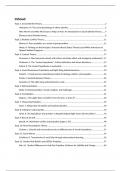Samenvatting
Understanding Prejudice: an interdisciplinary perspective on intergroup relations Articles Summary + additonal lecture notes
- Vak
- Instelling
Summary of all articles from the course Understanding Prejudice + additional information from the lectures. Topic 1: Social Identity Theory • (*) Ellemers, N., & Haslam, S.A. (2012). Social identity theory. In: P. van Lange, A. Kruglanski, & T. Higgins (Eds.). Handbook of theories of social...
[Meer zien]












